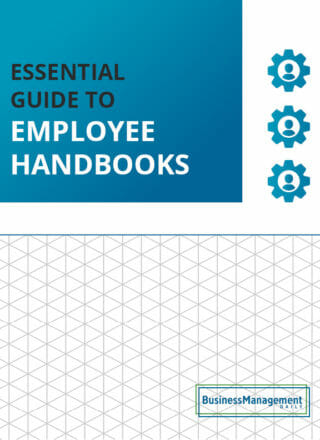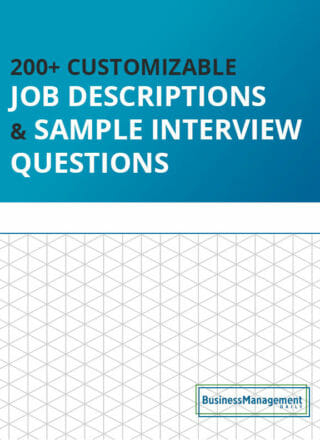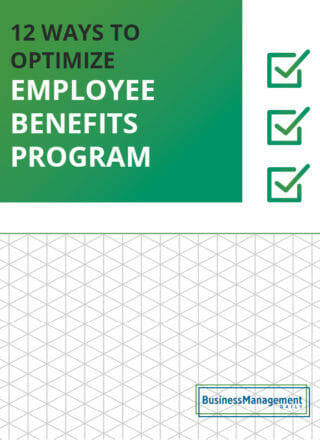Employee handbooks
Employee handbooks are a vital document, not only for human resources departments but for the entire organization. The employee handbook lays out key company policies as well as specific procedures. It is not only an important internal document, but it should also incorporate employment law, state laws, and any other documents needed to protect the organization in the case of potential lawsuits.
The employee handbook is, additionally, one of the first documents that a new employee will encounter during onboarding. Because of this, the employee handbook is one of the first documents an employee could encounter that helps establish your company culture.
Despite how important this document might be, it’s unlikely that a new hire or old employee will have all of these policies committed to memory. Therefore, the handbook is a key reference tool that can be used as needed to refer to individual policies.
So, what all do you need to know about your employee handbook? Whether you’re creating a handbook from scratch or updating your employee handbook, the base information you need to know is still the same.
Creating an employee handbook
Creating an employee handbook can seem like a daunting task, however, it doesn’t have to be. Following these simple steps will help you create an effective handbook that is valuable to your business and employees.
- Decide who will write it. Does your human resources team have the capacity? If so, they’re a natural choice, but in a small organization, an owner or manager may play a role here.
- Consider your business needs. Every organization isn’t the same. A business with remote or hybrid employees spread out will have different policy needs than one with a single office of in-person workers.
- Do your research. There are some basics that every handbook needs, but you’ll also need to factor in state laws in the states in which you operate as well as any other employment laws, both federal and local.
- Outline your handbook. There’s a lot to cover here, start with an outline to make sure everything is included. Then you can move on to actually filling it out.
- Start writing. Once your outline is made, being writing. Use specifics, but don’t be too specific, especially on disciplinary measures. You want to leave yourself flexibility in how you respond to a situation.
Note: When writing your employee handbook, consider incorporating some of this sample language to keep you out of trouble.
Employee handbook examples
When working on your employee handbook, there are a number of policies you must have. The list can be lengthy. For more on what policies to include, see this article on employee handbook examples.
Policies to include
Cell phone policy
More and more employees are expected to use their cell phones for work purposes, especially as more employers embrace remote and hybrid work. However, clear company cell phone policies need to be set in place. If you provide company phones, can they be used for personal business? Are employees expected to answer them during off-hours? If employees use their personal phones for work, are they eligible for reimbursement?
Code of conduct
This may include more general information, but also could include specific policies on how employees are expected to behave. Importantly, this should include your policies on sexual harassment and non-discrimination.
Conditions of employment.
Review the employment relationship between the employee and business. Most employees are under an employment-at-will agreement. That means their continued employment can be terminated by either the employer or employee at any point.
Credit card policy
Many companies use company credit cards to pay for expenses. Some may have employees submit for reimbursement. Either way, it is incredibly important to have a clear company credit card policy in place around the use of company cards, what expenses are reimbursable and tax-free, and most importantly, what documentation is needed. Poor documentation could lead to trouble with the IRS down the road.
Dress code
Dress codes can be a contentious topic, but expectations should be made clear in your handbook. However, be sure to craft inclusive and sensible policies. Consider clothing and hairstyles of various cultures, ethnicities, and religions. Be careful not to use overly gendered wording and policies that may reflect poorly on your organization.
Additionally, you may want to consider a different summer dress code to promote employee comfort. While this may seem strange, the workplace is quickly changing and the rigid policies of the old office don’t hold up as well today. So before you require suit jackets all summer and set a no-beard facial hair policy, think about if it’s really something necessary to your business.
Employee attendance
Your employee attendance policy should be well documented. What are the expectations for an employee to call out if they’re sick? If an employee is late, is that a strike against them? What are your expectations and policies for inclement weather?
Good attendance and punctuality are vital to an organization and repeat misconduct here should be addressed. However, it also needs to be addressed fairly and equally across all employees. Having a set policy ensures that you don’t find your organization on the wrong end of legal action.
Employee benefits
Information about your benefits plans like health insurance, COBRA coverage, workers’ compensation eligibility, and any other wellness benefits offered should be included. However, there’s little need to go into extreme details on health benefits and such, as these are likely to change year to year. Include general information about coverage and make detailed documents available elsewhere.
Employee leave policies.
There are a number of things to include here.
- Paid time off (PTO). Companies are exploring a variety of PTO policies now, some that incorporate separate sick leave and vacation time and others that combine them. Some even offer unlimited employee leave. Is PTO only offered to full-time employees, or do part-time employees qualify too? A competitive PTO policy is a vital part of attracting top-tier employees.
- FMLA laws. The Family and Medical Leave Act (FMLA) is a federal law that must be incorporated into your handbook if you’re a qualifying employer. Learn more about FMLA requirements and how they might impact your business.
- Medical leave. Include policies on the American’s with Disabilities Act and any other medical leave policies that your organization may have.
- Military leave is something else that should be included, especially in states with a large military presence. However, in any state employees may be part of the National Reserve Corps or have family members in the military.
- Jury duty. Include any policies on jury duty like what notification should be provided and how an employee on jury duty should handle it.
Equal employment opportunity statement
This is a key part of any employee handbook and should, at minimum, include categories protected by federal law and state employment law.
Mission statement and core values
Use this opportunity to establish your company culture. It may also describe the work environment and general goals of your company as well as how employees are expected to behave and perform.
Personnel records
Include how employee records will be kept and handled including disciplinary action, performance reviews, and any other employee documents.
Social media policy
Social media is something that can’t be ignored these days, whether your company is active on it or not, an employee’s actions on social media could ultimately reflect on their employer. It’s necessary to have a social media policy that protects your company, additionally, you should be prepared to address social media misconduct when necessary.
Travel policy
For many employers, employees have to travel, sometimes frequently, sometimes only occasionally. Whether your employees are constantly on the road or attending occasionally conferences, you’ll need a travel policy in place. This should include things like guidelines for booking accommodations, meal reimbursements, mileage, differences between exempt and non-exempt employees, and more.
Additionally, in your company travel policy, you may want to include a specific employee stipend policy.
Vehicle policy
Many companies have company vehicles or may require employees to use their personal vehicles for work. Even if you do not, occasional unexpected circumstances may come up. That’s why having a company vehicle policy is vital.
Who’s responsible for maintenance? Who pays if you get a ticket? What records and reimbursement documents need to be kept? These should all be addressed in your vehicle policy.
Company policy
When writing or updating your employee handbook, you may find that you also need to work on establishing or refining your company policies. Having well-defined company policies is vital to your organization’s success. As you’re working on your handbook or employee manual, take this time to update your employment policies and any other policies that might need to be adjusted.
Small business employee handbook
In many cases, small businesses have similar needs as their larger counterparts and a small business employee handbook will look similar. However, there are some cases where things may vary. For example, depending on the size of your business, the Family and Medical Leave Act (FMLA) may not apply to your business.
Additionally, you may be less likely to have a dedicated HR team. In this case, you may want to rely more on employee handbook templates and template policies to craft the majority of your handbook. These can be an invaluable and cost-saving tool.
[optin-monster slug="ihukqjuacadxdadygv7r"]

























